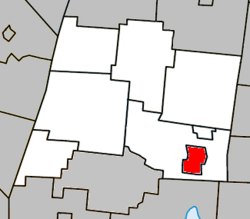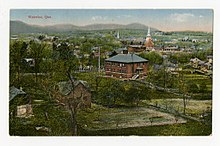Waterloo, Quebec
Waterloo | |
|---|---|
City | |
 | |
 Location within La Haute-Yamaska RCM | |
 Waterloo Location in southern Quebec | |
| Coordinates: 45°21′N 72°31′W / 45.350°N 72.517°WCoordinates: 45°21′N 72°31′W / 45.350°N 72.517°W[1] | |
| Country | Canada |
| Province | Quebec |
| Region | Montérégie |
| RCM | La Haute-Yamaska |
| Established | January 01, 1867 |
| Constituted | January 1, 1867 |
| Government | |
| • Mayor | Jean-Marie Lachapelle |
| • Federal riding | Shefford |
| • Prov. riding | Brome-Missisquoi |
| Area | |
| • Total | 13.30 km2 (5.14 sq mi) |
| • Land | 12.24 km2 (4.73 sq mi) |
| Population | |
| • Total | 4,410 |
| • Density | 360.2/km2 (933/sq mi) |
| • Pop 2011-2016 | |
| • Dwellings | 2,124 |
| Time zone | UTC−5 (EST) |
| • Summer (DST) | UTC−4 (EDT) |
| Postal code(s) | J0E |
| Area code(s) | 450 and 579 |
| Highways | |
| Website | www |
Waterloo (2016 population 4,410[4]) is a city in Quebec, included in La Haute-Yamaska Regional County Municipality, in the administrative area of Montérégie. Completely encircled by the township of Shefford, this residential city is located within the Eastern Townships, about ninety kilometers east of Montreal.
History[]
This section does not cite any sources. (April 2012) |

The town was first settled in 1793 by Ezekiel Lewis, an English Loyalist supporter who was originally from Marlborough, New Hampshire. He named his location Lewis Falls and after 9 years, Captain Lewis sold his lot and moved a short distance away. The land was purchased by William Lamoure, a merchant from St-Armand who then sold it to Lazare Letourneau who in turn sold it to Hezekiah Robinson in 1822. Robinson immediately renamed Lewis Falls to Waterloo after the famous battle in which Napoleon Bonaparte was defeated. The name Waterloo was suggested by his father-in-law, Judge Knowlton. Hezekiah Robinson built "The Old Stone Store" in 1829 at the corner of Main Street and Ellis.He donated the land for the first Church of England built in 1843 and his widow donated Robinson Park in 1868 plus the land for the French school. In 1843, Waterloo became the county seat replacing Frost Village.
In 1861, Asa Belnap Foster, a prominent Canadian railway builder and politician, brought the railroad to Waterloo which helped expand the village to a thriving town. Its population increased from 200 in 1857 to 1500 in 1867. Foster developed the south end of the town where the railway station was located and connected the old village to it by constructing Foster Street, at his own expense, which still exists today as Waterloo's main street. A. B Foster also donated the land for all the churches in town plus the local high school. Additionally, Foster also rebuilt Lewis Bridge at his own expense when the bridge fell into disrepair. In 1864 Colonel Foster built Maplewood, a beautiful estate on Clark Hill. When Waterloo was incorporated in 1867, A.B. Foster was elected its first mayor.

Waterloo has been the home of a number of noteworthy persons including A.B. Foster - a former member of Parliament, Canadian Senator, colonel of the militia and railway baron known as "Canada's Railway King". Also, John R. Booth was born in Waterloo in 1827 and after moving to Ottawa became one of the wealthiest men in Canada and was known as "The Lumber King Of Canada". Lucius Huntington, a Waterloo resident and local member of Parliament revealed in a speech in Parliament the details of what was to become "the Pacific Scandal" which lead to the election defeat of Sir John A. Macdonald. (the Conservative Party believed A. B. Foster was his source).
Waterloo became the summer residence of Montreal industrialist James Davidson in the 1880s. Davidson was the son of Scottish immigrant Thomas Davidson, who founded The Thos. Davidson Manufacturing Company, Ltd., a producer of enameled tinware with offices throughout Canada and around the world. Davidson established "Ayrmont Farm" on the western side of the town. The main house, "Orford View," still stands on Mountain Street. The guest bungalow across the road and surrounding property are still in the hands of the family.
Today, the town is the only Waterloo in the world outside Europe that is predominantly French-speaking; the remainder are all located in English-speaking regions.
Demographics[]
Population[]
Population trend:[5]
| Census | Population | Change (%) |
|---|---|---|
| 2016 | 4410 | |
| 2011 | 4,330 | |
| 2006 | 4,054 | |
| 2001 | 3,993 | |
| 1996 | 4,040 | |
| 1991 | 3,989 | N/A |
Language[]
Mother tongue language[6]
| Language | Population 2006 | Pct (%) 2006 | Population 2016 | Pct (%) 2016 |
|---|---|---|---|---|
| French only | 3,095 | 79.05% | 3,535 | 83.18% |
| English only | 710 | 18.14% | 600 | 14.12% |
| Both English and French | 60 | 1.53% | 75 | 1.76% |
| Other languages | 50 | 1.28% | 35 | 0.82% |
Twin Cities[]
Waterloo, Quebec, was bound in 1957 with the town of Waterloo in Belgium. To commemorate this union each of the two Waterloos have in them a statue representing a little boy and a small girl sheltering under a mushroom.
See also[]
- List of cities in Quebec
References[]
- ^ Reference number 66717 of the Commission de toponymie du Québec (in French)
- ^ Jump up to: a b Ministère des Affaires municipales, des Régions et de l'Occupation du territoire: Waterloo
- ^ Parliament of Canada Federal Riding History: SHEFFORD (Quebec)
- ^ Jump up to: a b c 2016 Statistics Canada Census Profile: Waterloo, Quebec
- ^ Statistics Canada: 1996, 2001, 2006, 2011, 2016 census
- ^ 2006 Statistics Canada Community Profile: Waterloo, Quebec
External links[]
![]() Media related to Waterloo, Quebec at Wikimedia Commons
Media related to Waterloo, Quebec at Wikimedia Commons
- Waterloo, Quebec
- Incorporated places in La Haute-Yamaska Regional County Municipality
- Cities and towns in Quebec
